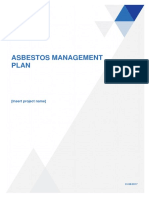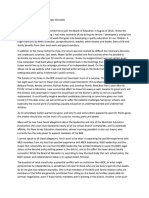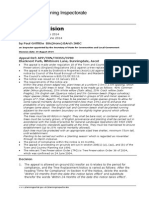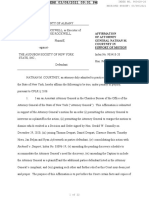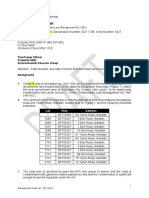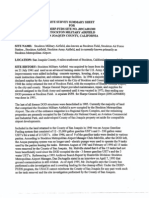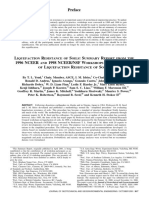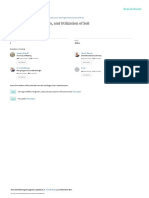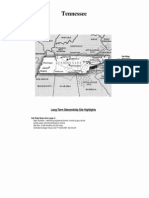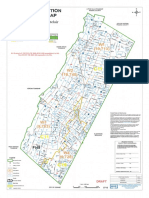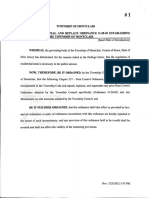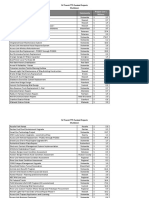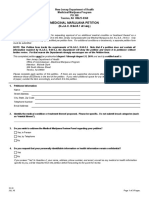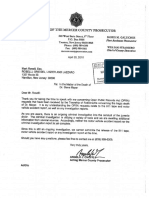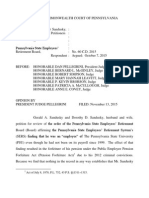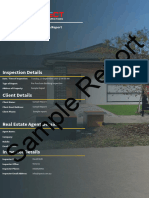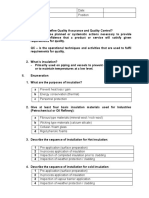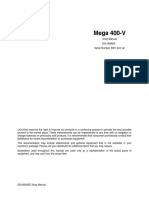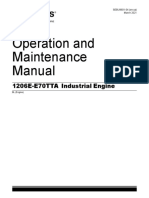0 ratings0% found this document useful (0 votes)
6K viewsRadiation Technologies Superfund Plan
Radiation Technologies Superfund Plan
Uploaded by
Louis C. HochmanThe EPA plans to demolish 34 contaminated buildings at the Radiation Technologies site near Picatinny Arsenal.
Copyright:
© All Rights Reserved
Available Formats
Download as PDF, TXT or read online from Scribd
Radiation Technologies Superfund Plan
Radiation Technologies Superfund Plan
Uploaded by
Louis C. Hochman0 ratings0% found this document useful (0 votes)
6K views11 pagesThe EPA plans to demolish 34 contaminated buildings at the Radiation Technologies site near Picatinny Arsenal.
Original Title
Radiation Technologies Superfund plan
Copyright
© © All Rights Reserved
Available Formats
PDF, TXT or read online from Scribd
Share this document
Did you find this document useful?
Is this content inappropriate?
The EPA plans to demolish 34 contaminated buildings at the Radiation Technologies site near Picatinny Arsenal.
Copyright:
© All Rights Reserved
Available Formats
Download as PDF, TXT or read online from Scribd
Download as pdf or txt
0 ratings0% found this document useful (0 votes)
6K views11 pagesRadiation Technologies Superfund Plan
Radiation Technologies Superfund Plan
Uploaded by
Louis C. HochmanThe EPA plans to demolish 34 contaminated buildings at the Radiation Technologies site near Picatinny Arsenal.
Copyright:
© All Rights Reserved
Available Formats
Download as PDF, TXT or read online from Scribd
Download as pdf or txt
You are on page 1of 11
EPA ANNOUNCES PROPOSED PLAN
This Proposed Plan identifies the Preferred Alternative
to address contaminated buildings and structures at the
Radiation Technology, Inc., (RTI) Superfund Site in
Rockaway Township, New J ersey. In addition, this Plan
includes summaries of cleanup alternatives evaluated
for use at the Site. The proposed remedy addresses on-
site contaminated buildings/structures contaminated
with polychlorinated biphenyls (PCBs); asbestos-
containing material (ACM) and lead. This Proposed
Plan was developed by the U.S. Environmental
Protection Agency (EPA), the lead agency for the Site,
in consultation with the New J ersey Department of
Environmental Protection (NJ DEP), the support
agency. EPA, in consultation with NJ DEP, will select a
final remedy for contaminated buildings/structures at
the Site after reviewing and considering all information
submitted during a 30-day public comment period.
EPA, in consultation with NJ DEP, may modify the
Preferred Alternative or select another response action
presented in this Plan based on new information or
public comments. Therefore, the public is encouraged
to review and comment on all the alternatives presented
in this Proposed Plan.
EPA is issuing this Proposed Plan as part of its public
participation responsibilities under Section 117(a) of
the Comprehensive Environmental Response,
Compensation, and Liability Act (CERCLA or
Superfund). This Proposed Plan summarizes
information that can be found in greater detail in the
final remedial investigation (RI) report and final
focused feasibility study (FFS) report and other
documents contained in the Administrative Record file
for this Site.
SITE DESCRIPTION
The former RTI Site is located at 108 Lake Denmark
Road, Rockaway Township, New J ersey, near the
small residential community of Lake Telemark, New
J ersey, in the western portion of Morris County. The
area around the Site is generally low-density residential
properties. The Picatinny Military Arsenal is located to
the west of the Site. Areas to the east of the Site consist
of mainly single-family residences. In 2006, the entire
Site was designated as a federal Superfund Site. The
Site consists of 263 acres of land (see Figure 1-1) and is
divided into the following developed areas: RTI Area
(15 acres), currently occupied by Sterigenics
International, which is not part of this Proposed Plan,
East Stand Area (22 acres), South Stand Area (27
acres), and P2 Area (16 acres). The remaining portion
(183 acres) consists of undeveloped wooded land. The
RTI Area and the undeveloped land are not included as
Superfund Proposed Plan U.S. Environmental Protection
Agency, Region II
Radiation Technology, Inc., Superfund Site
Rockaway Township, New J ersey
March 2014
MARK YOUR CALENDARS
Public Comment Period
March 24 April 23, 2014
EPA will accept written comments on the Proposed
Plan during the public comment period.
Public Meeting
April 3, 2014 at 7:30 P.M.
EPA will hold a public meeting to explain the
Proposed Plan and all of the alternatives presented in
the Focused Feasibility Study Report. Oral and written
comments will also be accepted at the meeting. The
meeting will be held at the Rockaway Township
Municipal Building, located at 65 Mount Hope
Road, Rockaway, New J ersey 08341 at 7:30pm.
For more information, see the Administrative
Record at the following locations:
EPA Records Center, Region 2
290 Broadway, 18
th
Floor
New York, New York 10007-1866
(212) 637-4308
Hours: Monday-Friday 9 A.M. to 5 P.M.
Rockaway Township Free Public Library
61 Mount Hope Road
Rockaway, New J ersey 08341
(973) 627-2344
Hours: Monday - Friday 9 am to 9 pm
2
part of this Proposed Plan. The four developed areas of
the Site are restricted from public access by a fence. A
1994 Record of Decision (ROD) for Operable Unit
(OU) 1 selected a remedy to address contaminated
groundwater Site wide. A pre-design investigation is
underway. A 2011 ROD for OU2 was issued for a
drum-disposal area found during an investigation of
Site soils. A remedial action is expected to be
completed in 2014. OU3 consists of 34 historically
industrial or commercial structures. Most of the
structures are in poor condition after having been
vacant and/or having received no maintenance since
2006.
SITE HISTORY
Background/Site Characteristics
The Site is located in a predominantly rural area in the
western portion of Morris County, New J ersey, at 108
Lake Denmark Road in the Township of Rockaway. It
is situated approximately five miles north of Exit 37 of
Interstate 80.
Prior to 1941, the RTI Superfund Site was owned by
the Singer Manufacturing Company. Reaction Motors,
Inc., purchased the property in 1941 and in
approximately 1947 began the construction of facilities
to support rocket motor and component testing
programs. Reaction Motors, Inc., was acquired by a
corporate predecessor to the Olin Corporation in 1953
and thereafter by Thiokol Chemical Corporation
(Thiokol) in 1958. In 1964, Reaction Motors, Inc., was
formally combined with Thiokol and became a separate
working division within the company. A 1991 RI
Report provides a detailed summary of historical
building use by Reaction Motors and Thiokol. In 1972,
RTI purchased a 15-acre parcel of the Site (now known
as the RTI Area) and conducted irradiation activities
until it sold these operations in 1996. In 1978, RTI
purchased the remaining 248 acres of the Site from
Thiokol and leased portions of the property to various
tenants. Sterigenics International continues to occupy
buildings within the RTI Area.
Beginning in 1980, NJ DEP and the Rockaway
Township Health Department conducted numerous
inspections of the Site. These inspections revealed that
drums containing solvents and other organic chemicals
were being improperly stored and disposed of by the
owner and operator of the Site, Radiation Technology,
Inc.
In 1981, the Rockaway Township Health Department
sampled two on-Site water supply wells. Results
indicated that volatile organic compounds (VOCs) had
contaminated the groundwater supplying these wells.
They subsequently were condemned by the New J ersey
Department of Health and the NJ DEP, and were closed.
On J uly 6, 1983, NJ DEP and RTI signed a judicial
Consent Order, which required RTI to install ground
water monitoring wells and collect samples for VOC
analyses to determine the source of the contamination.
In August 1984, NJ DEP issued a Site Evaluation
Report with the objective of identifying sources of
groundwater contamination at and around the RTI
property. The results of the well sampling and analysis
indicated that elevated levels of VOCs were present in
the samples analyzed. Subsequently, the Site was
placed on the National Priorities List (NPL) of
Superfund sites in September 1984.
On March 12, 1987, RTI entered into an Administrative
Order on Consent (AOC) with NJ DEP and agreed to
pay the cost of an investigation into the nature and
extent of contamination at the Site. On December 12,
1992, RTI signed a second AOC with NJ DEP, agreeing
to perform some cleanup activities at the Site. In May
1993, under NJ DEP supervision, RTI removed and
disposed of abandoned tanks and drums off Site
resulting from the above investigation. On May 9,
1994, NJ DEP issued a ROD for OU1, selecting
groundwater extraction and treatment as the remedy for
the most-contaminated portion of the Site.
The State of New J ersey entered into an AOC with RTI
and Thiokol Corporation to reimburse NJ DEP costs for
a portion of the RI/FS and to conduct design and
remedial activities for contaminated groundwater under
NJ DEP oversight. Pursuant to the ACO and a
Settlement Agreement, Thiokol Corporation paid
certain monies to RTI and RTI agreed to complete the
investigation and remediation of the Site. RTI began
working on the remedial design soon after the ROD
was signed in 1994. However, RTI wished to alter the
remedy. Under NJ DEP oversight, RTI performed
several pilot studies of in situ chemical oxidation
between 1995 and 1997. The results of these studies
were inconclusive and RTI resumed design for the
ROD-designated remedy in 1998. The groundwater
remedy was partially designed, but work was suspended
in early 1999 due to financial difficulties of RTI.
3
In J anuary 2000, RTI filed for Chapter 11 bankruptcy.
In November 2000, the NJ DEP requested that the EPA
assume the lead for the Site, to which the EPA agreed
in J anuary 2001. RTIs bankruptcy petition was
dismissed by the Court in December 2000 for RTIs
failure to file the required reports and pay appropriate
fees.
REMEDIAL INVESTIGATION
In May 2004, EPA negotiated a Consent Decree with
Alliant Techsystems, Inc. (ATK) (a successor to
Thiokol, a former owner and operator of the Site), to
undertake the groundwater cleanup. In September 2004
and April 2005, ATK conducted groundwater sampling
as part of a preliminary design investigation to obtain a
better understanding of the groundwater contamination
conditions and to confirm the viability of the
groundwater remedy selected in the 1994 ROD. The
results indicated that further sampling would be
necessary and ATK recommended that additional
monitoring wells be installed. Presently, ATK is
conducting an in-situ pilot test involving the injection
of emulsified oils into the fractured bedrock to
determine the effectiveness of this technology to treat
groundwater contamination. Final pilot test sampling
results are expected in March 2014. In October 2004,
ATK and EPA entered into an AOC to investigate
potential sources of groundwater contamination at the
Site. ATK conducted a preliminary assessment of a
waste/drum disposal area located within the active
former RTI complex. The waste/drum disposal area
investigation led to the selection of a remedy for the
drum material and surrounding contaminated soils in a
2011 ROD for OU2. The selected remedy included
excavation and off-site disposal and/or treatment.
The OU3 RI/FFS for buildings and structures remaining
on-site began in 2012. The RI/FFS work was
conducted by E&E, pursuant to an Interagency
Agreement with the United States Army Corps of
Engineers at the direction of the EPA. During the OU3
RI, the following portions of the site were investigated
(see Figure 1-2):
East Stand Area (22 acres);
South Stand Area (27 acres); and
P2 Area (16 acres).
Initially, E & Es Technical Memorandum summarized
the review of 34 buildings/structures, which determined
that 26 of the 34 buildings needed additional sampling.
After further review, a total of 25 buildings/structures
remained to be sampled for the RI. A cultural resource
investigation was conducted for the RI and consisted of
a National Register of Historic Places (NRHP)
eligibility evaluation of 34 structures and buildings plus
five additional structures (e.g., guard house, water
towers) within these areas but not technically within the
survey. A notification to the NJ DEP State Historic
Preservation Officer regarding the potential for listing
the site on the National Register of Historic Places and
(check with Steve F). E & Es RI fieldwork included
areas only in OU3 (East Stand Area, South Stand Area,
and P2 Area), including the 25 buildings/structures that
were identified as requiring additional sampling in the
Technical Memorandum. The OU3 areas of the site are
currently fenced and posted to restrict public access.
Most buildings/structures on-site are dilapidated or in
poor condition, having been vacant since at least 2006.
Investigations in 199 and 20 assessed the 15 acre RTI
(now Steregenics) property and the 183-acre
undeveloped wooded land and concluded that no
further studies were needed. These areas do not need to
be addressed by a remedy and were not carried forward
as part of the RI/FFS.
SCOPE AND ROLE OF THE ACTION
EPA is addressing the cleanup of the Site in three
phases, called operable units. This Proposed Plan for
OU3, addresses contaminated buildings and structures
found at the Site. As stated earlier, EPA previously
conducted two separate studies that concluded with
RODs for OU1 (site groundwater) and OU2 (drum
disposal area). This is expected to be the final action
for the Site.
4
SUMMARY OF SITE RISKS
As part of the RI/FFS, a Screening-Level Risk
Assessment (SLRA) was conducted to estimate current
and future effects of contaminants on human health. A
standard Baseline Human Health Risk Assessment
could not be performed, since the bulk building
materials sampled are not available for reasonable
dermal, ingestion or inhalation exposure. The SLRA,
however, is a screening analysis for potentially
hazardous substances on-site where there is a release or
threat of release into the environment which could
constitute a public health or environmental hazard. The
concentrations of contaminants found in the various
bulk material samples were compared with Removal
Management Screening Levels (which assume
residential use) and risk-based screening levels for
residential and industrial soils from EPAs Regional
Screening Tables. So while the steps of a SLRA differ
from a standard Baseline Human Health Risk
Assessment, the application of the major concepts is the
same. An ecological risk assessment was not done
because buildings are not considered an ecological
habitat. A SLRA was previously conducted that
indicated that concentrations of contaminants detected
in surface soil, surface water and sediment at the RTI
Site are unlikely to pose any unacceptable risks to
terrestrial or aquatic receptors of concern identified at
the RTI Site.
Hazard Identification:
PCBs
Various buildings and structures had elevated levels of
metals and PCBs in the concrete bulk samples, PCBs in
caulk, as well as remnants of oil sludge in standing
water and containers in the buildings. PCB sampling
results ranged from 0 to 65 milligrams per kilogram
(mg/kg) with an anomalous detection of 680 mg/kg.
These results exceeded the NJ DEP Non-Residential
Direct Contact Health Based Screening Criteria and
Soil Remediation Standards.
Asbestos
A total of 98 bulk samples of suspect ACM were
collected and submitted for analysis. Different types of
ACM (thermal system insulation and/or miscellaneous)
were identified in 15 buildings/structures out of total of
34 at the RTI Site: East Stand Area (seven buildings);
South Stand Area (four buildings) and P2 Area (four
buildings). A total of 44 ACMs were confirmed through
laboratory results to contain asbestos. Two areas with
suspected ACM could not be sampled due to
accessibility issues, and as such were assumed to be
ACM. These materials include both friable asbestos
materials (that can be crumbled, pulverized, or reduced
to powder under hand pressure) and non-friable
organically bound asbestos materials. The condition of
all of the buildings and structures was identified as
poor.
Lead
A total of 424 X-ray fluorescence (XRF) readings were
taken within the 21 identified structures with suspect
components. An XRF is an X-ray instrument used for
routine, relatively non-destructive chemical analyses of
rocks, minerals, sediments and fluids. A total of 36
chips from different building components and locations
throughout East Stand, South Stand and P2 Areas
(where surfaces were identified) were collected and
sent to EMSL Analytical, Inc., for analysis. Lead
(including lead-based paint (LBP)) was identified by
XRF screening as present in poor condition within all
three project areas on concrete walls, window sills,
metal columns, and metals doors. Out of 36 chip
samples tested, 19 samples had lead concentrations
WHAT ARE THE CONTAMINANTS OF CONCERN
(COCs)?
The COCs in OU3 (buildings and structures) are primarily
asbestos, PCBs, and lead.
Asbestos-contaning material (ACM): The term asbestos
refers to a group of naturally occurring silicate minerals
separable into commercially usable fibers, including chrysotile
(serpentine), amosite (cumingtonite-grunerite), crocidolite
(riebeckite), tremolite, anthophyllite and actinolite. According to
NESHAP, any material containing more than one percent
asbestos is classified as ACM (NESHAP 40 CFR Part61).
Asbestos use was common through the 1970s for fireproofing
purposes, but started to decline from 1973 to 1978 when EPA
banned all spray applied asbestos materials.
Polychlorinated Biphenyls (PCBs): PCBs were widely used as
a fire preventative and insulator in the manufacturing of
transformers and capacitors because of their ability to withstand
exceptionally high temperatures. PCBs are considered probable
human carcinogens and are linked to other adverse health effects
such as developmental effects, reduced birth weights and
reduced ability to fight infection.
Lead: Exposure to excessive levels of lead can cause brain
damage; affect a childs growth; damage kidneys; impair
hearing; cause vomiting, headaches, and appetite loss; and cause
learning and behavioral problems. In adults, lead can increase
blood pressure and can cause digestive problems, kidney
damage, nerve disorders, sleep problems, muscle and joint pain,
and mood changes.
5
greater than 0.5 percent by dry weight, or 1 milligram
per square centimeter (mg/cm), and are considered to
contain LBP. The condition of all of the buildings and
structures was identified as poor.
Exposure Assessment: Since the site is presently
unused, the only human exposures likely to occur under
existing conditions are occasional brief exposures of
site trespassers. Since the buildings and structures are in
poor condition, environmental conditions could lead to
a release of PCBs, ACM and/or lead to the
environment. Potential lead exposure could most likely
result from incidental ingestion of lead containing dust
and chips. Inhalation of airborne dust is also possible,
but is less likely than incidental ingestion and would
probably result in much smaller exposures.
Health Effects Assessment:
Asbestos
Asbestos fibers can enter the body through inhalation,
ingestion, and absorption. Health effects involving
exposure to asbestos fibers include lung cancer,
mesothelioma (cancer of pleural or peritoneal cavity
linings), gastrointestinal cancers, asbestosis (scarring of
the lungs), and other forms of lung diseases.
Lead
Exposure to excessive levels of lead can cause brain
damage; affect a childs growth; damage kidneys;
impair hearing; cause vomiting, headaches, and appetite
loss; and cause learning and behavioral problems. In
adults, lead can increase blood pressure and can cause
digestive problems, kidney damage, nerve disorders,
sleep problems, muscle and joint pain, and mood
changes.
PCBs
Exposure to excessive levels of PCBs is linked to other
adverse health effects such as developmental effects,
reduced birth weights and reduced ability to fight
infection.
Uncertainties
There are a number of sources of uncertainty in this
SLRA, primarily due to the lack of complete
quantitative risk calculations. Several chemicals that
were measured analytically in the bulk materials lack
screening levels because they lack quantitative toxicity
values. Other chemicals exist in several forms that can
be measured analytically but for which separate toxicity
values have not been established. In these cases
screening levels for the parent compound or a very
closely related compound were used as surrogates. In
general, bulk building materials are not analyzed and
included in risk assessments due to limited human
health exposure. However, an action was warranted at
this Site due to the extremely deteriorated condition of
the buildings and lack of security at the Site, allowing
potential trespassers to access deteriorated structures
and become exposed to contaminated materials that
pose a risk to human health.
REMEDIAL ACTION OBJECTIVES
Based on the SLRA identification of exposure
pathways, the following list of Remedial Action
Objectives (RAOs) for OU3 was developed for
protection of human health and the environment:
Prevent direct and dermal contact with, and inhalation
or ingestion of, PCBs from transformer oil, caulking
compounds, and contaminated concrete and
cinderblock;
WHAT IS RISK AND HOW IS IT CALCULATED?
A Superfund baseline human health risk assessment is an analysis of the
potential adverse health effects caused by hazardous substance releases froma
Site in the absence of any actions to control or mitigate these under current- and
future-land uses. This was not completed for the Site, however a Screening-
Level Risk Assessment (SLRA) was performed. While the steps of a SLRA
differ froma standard Baseline Human Health Risk Assessment, the application
of the major concepts is the same. The adapted four-step process utilized for
assessing site-related contaminants and potential human health risks for is
described below.
Hazard Identification: In this step, the chemicals of potential concern (COPCs)
at the Site in various media (i.e., soil, groundwater, surface water, and air) are
identified based on such factors as toxicity, frequency of occurrence, and fate
and transport of the contaminants in the environment, concentrations of the
contaminants in specific media, mobility, persistence, and bioaccumulation.
Exposure Assessment: In this step, the different exposure pathways through
which people might be exposed to the contaminants identified in the previous
step are evaluated. Examples of exposure pathways include incidental ingestion
of and dermal contact with contaminated building materials. Factors relating to
the exposure assessment include, but are not limited to, the concentrations in
specific media that people might be exposed to and the frequency and duration
of that exposure. Using these factors, a reasonable maximum exposure
scenario, which portrays the highest level of human exposure that could
reasonably be expected to occur, is calculated.
Health Effects Assessment: Normally a toxicity assessment, in this step, the
types of adverse health effects associated with contaminant exposures are
determined. Potential health effects are chemical-specific and may include the
risk of developing cancer over a lifetime or other non-cancer health hazards,
such as changes in the normal functions of organs within the body (e.g., changes
in the effectiveness of the immune system). Some chemicals are capable of
causing both cancer and non-cancer health hazards.
Risk Characterization: This step could not be performed due to the nature of the
contamination at the Site. In a standard risk assessment process, characterization
summarizes and combines outputs of the exposure and toxicity assessments to
provide a quantitative assessment of Site risks for all COPCs.
.
6
Prevent direct and dermal contact with, and ingestion
of, contaminated water, sediment, and sludge in
aboveground storage tanks and sumps;
Prevent the release or the threat of release of lead-based
paint into the environment resulting from deterioration
of on-site structures; and
Prevent the release or the threat of release of asbestos
into the environment resulting from deterioration of on-
site structures.
Remedies and development of groundwater RAOs are
not part of OU3 and are not included as part of this
FFS. Additionally, although one sub-slab soil
exceedence was detected, due to the nature of the
alternatives, it is not anticipated that contaminated soil
will be disturbed during remedial activities. PCBs were
found in some building media such as water, sediment
and sludge in aboveground storage tanks and will be
addressed with rest of buildings/structures.
Remediation of the structure (including a concrete slab)
with sub-slab contamination will be limited to
encapsulation or the scarification of the top surface and
it is not anticipated that full foundation demolition and
removal will be conducted. However, the extent of
building/structure demolition and/or selective removal
may change during the remedial design process based
on new information such as building stability.
There are no principal threat wastes in this OU.
SUMMARY OF REMEDIAL ALTERNATIVES
All of the remedial alternatives except Alternative 1
include long-term monitoring of the Site and
institutional controls (in the form of a deed notice) to
limit future land uses because contamination remains
underneath the concrete slabs. Only alternative 2 will
require operation and maintenance (O&M).
Institutional controls are administrative and legal
controls that help to minimize the potential for human
exposure to contaminants. Given the expected future
use for this Site, unrestricted use would not be
anticipated. New J erseys promulgated standard for
unrestricted use would require that, at a minimum, land
use would need to be controlled to prevent unrestricted
(e.g., residential) use. All alternatives would result in
contamination remaining on-site above levels that
would allow unrestricted use; therefore, five-year
reviews are required.
Alternative 1 - No Action
Total Capital Cost $0
Annual O&M $0
Total Present Net Worth $0
Timeframe 0 years (yrs)
Regulations governing Superfund program remedy
selection require that the no action alternative be
evaluated to establish a baseline for comparison to other
alternatives. Under this alternative, EPA would take no
action at the Site to prevent potential exposure to
buildings/structures contamination.
Alternative 2 Building Decontamination and
Encapsulation
Total Capital Cost $1,507,000
Annual O&M $23,000
Total Present Net Worth $2,560,000
Timeframe 1 yr +30 yrs O&M
Under this alternative, selective building rehabilitation
would be undertaken. This includes the cleaning and
encapsulation of contaminated concrete and
cinderblock; removal of source caulk and sealant
material (PCB concentrations greater than 0.2 ppm);
collection and disposal of contaminated surface water,
oils, sludge, and sediment; and abatement of ACM and
lead. This alternative assumes that non-hazardous
debris that is scattered around many of the structures
will only be removed if it is necessary for remedy
implementation. Under this alternative O&M refers to
WHAT IS A " PRINCIPAL THREAT" ?
The NCP establishes an expectation that EPA will use treatment
to address the principal threats posed by a site wherever
practicable (NCP Section 300.430(a)(1)(iii)(A)). The "principal
threat" concept is applied to the characterization of "source
materials" at a Superfund site. A source material is material that
includes or contains hazardous substances, pollutants or
contaminants that act as a reservoir for migration of
contamination to ground water, surface water or air, or acts as a
source for direct exposure. Contaminated ground water
generally is not considered to be a source material; however,
Non-Aqueous Phase Liquids (NAPLs) in ground water may be
viewed as source material. Principal threat wastes are those
source materials considered to be highly toxic or highly mobile
that generally cannot be reliably contained, or would present a
significant risk to human health or the environment should
exposure occur. The decision to treat these wastes is made on a
site-specific basis through a detailed analysis of the alternatives
using the nine remedy selection criteria This analysis provides a
basis for making a statutory finding that the remedy employs
treatment as a principal element.
7
the monitoring the competency of the encapsulation to
prevent leaching of PCBs to surface and necessary
repairs to ensure its integrity.
Alternative 3 Structure Demolition/Selective
Removal
Total Capital Cost $1,963,000
Annual O&M $0
Total Present Net Worth $1,990,000
Timeframe 2 yrs
Under this alternative, selective building demolition
and off-site waste disposal would be undertaken. This
alternative includes either complete demolition of the
buildings/structures or scarification of contaminated
concrete surfaces. This alternative also includes
removal of concrete bulk materials, PCBs in caulk, as
well as remnants of oil sludge in standing water, oils,
sludge, and sediment; and abatement of ACM and lead.
Abatement of lead is only required for structures that
would not be demolished, and abatement prior to
demolition of a structure is not required as the bulk
waste can be disposed of or recycled together under
New J ersey regulations. This alternative assumes that
non-hazardous debris that is scattered around many of
the structures will only be removed if it is necessary for
remedy implementation.
EVALUATION OF ALTERNATIVES
Nine criteria are used to evaluate the different
remediation alternatives individually and against each
other in order to select a remedy. This section of the
Proposed Plan profiles the relative performance of each
alternative against the nine criteria, noting how it
compares to the other options under consideration. The
nine evaluation criteria are discussed below. The
Detailed Analysis of Alternatives can be found in the
FFS.
Overall Protection of Human Health and the
Environment
Since Alternative 1 (no further action) would not
address the risks posed by building contaminants, it
would not be protective of human health and the
environment.
The other two alternatives would provide adequate
protection of human health and the environment by
eliminating, reducing, or controlling risk through
treatment, removal or containment. Contaminants
would be removed or contained through Alternatives 2
(Building Decontamination and Encapsulation) and
Alternative 3 (Structure Demolition/Selective
Removal).
Because the no action alternative, Alternative 1, is
not protective of human health and the environment, it
was eliminated from further consideration under the
remaining eight criteria
THE NINE SUPERFUND EVALUATION CRITERIA
1. Overall Protectiveness of Human Health and the Environment
evaluates whether an alternative eliminates, reduces, or controls threats to
public health and the environment through institutional controls,
engineering controls, or treatment.
2. Compliance with Applicable or Relevant and Appropriate
Requirements (ARARs) evaluates whether the alternative meets federal
and state environmental statutes, regulations, and other requirements that
pertain to the site, or whether a waiver is justified.
3. Long-term Effectiveness and Permanence considers the ability of an
alternative to maintain protection of human health and the environment
over time.
4. Reduction of Toxicity, Mobility, or Volume (TMV) of
Contaminants through Treatment evaluates an alternative's use of
treatment to reduce the harmful effects of principal contaminants, their
ability to move in the environment, and the amount of contamination
present.
5. Short-term Effectiveness considers the length of time needed to
implement an alternative and the risks the alternative poses to workers,
the community, and the environment during implementation.
6. Implementability considers the technical and administrative feasibility
of implementing the alternative, including factors such as the relative
availability of goods and services.
7. Cost includes estimated capital and annual operations and
maintenance costs, as well as present worth cost. Present worth cost is
the total cost of an alternative over time in terms of today's dollar value.
Cost estimates are expected to be accurate within a range of +50 to -30
percent.
8. State/Support Agency Acceptance considers whether the State
agrees with the EPA's analyses and recommendations, as described in the
RI/FS and Proposed Plan.
9. Community Acceptance considers whether the local community
agrees with EPA's analyses and preferred alternative. Comments
received on the Proposed Plan are an important indicator of community
acceptance.
8
Compliance with ARARs
Actions taken at any Superfund site must meet all
ARARs for federal and state law or provide grounds for
invoking a waiver of these requirements. These include
chemical-specific, location-specific, and action-specific
ARARs. All chemical-specific, location-specific, and
action-specific ARARs can be met for Alternatives 2
and 3. For buildings containing PCBs, both Alternative
2 and Alternative 3 meet the chemical-specific ARARs.
Additionally, both Alternative 2 and Alternative 3
would prevent direct contact with contaminated
surfaces and would comply with all ARARs. The
Toxic Substances Control Act of 1976 is an ARAR for
Alternatives 2 and 3 due to off-site transportation and
disposal of PCB-contaminated material. Alternative 2
would comply with 40 CFR 761.30(p), regarding the
use of PCB-contaminated surfaces. Under Alternative
3, PCB-contaminated materials would be remediated
consistent with 40 CFR 761.79. RCRA is a federal law
that mandates procedures for managing, treating,
transporting, storing and disposing of hazardous
substances. All portions of RCRA that are applicable
or relevant and appropriate would be met by either
Alternatives 2 or 3. Some of the structures at the Site
have the potential to qualify as historic properties
because of the activities of the rocket motor testing. As
a result, further investigation must be performed to
determine if the on-site structures qualify as historic
properties. Both alternatives meet ARARs for ACM
and LBP abatement.
Long-Term Effectiveness and Permanence
Alternatives 2 and 3 would provide some level of long-
term effectiveness, assuming proper O&M of the
encapsulation coatings. Alternative 2 would leave
contaminated material on-site and require O&M;
Alternative 3 offers more permanence since
contaminated material is completely removed from the
Site and no further O&M is required.
Reduction of Toxicity, Mobility, and Volume
Through Treatment
For ACM and LBP, Alternative 2 does not reduce the
toxicity or volume of the waste through treatment, but
does reduce potential for mobility. However the
decontamination process prior to encapsulation will
reduce the toxicity, mobility, and volume of PCBs
through treatment. Alternative 3 does not reduce the
toxicity or volume since it just removes PCBs, ACM
and LBP from the Site to another location, but it does
reduce its potential for mobility.
Short-Term Effectiveness
Alternative 2 would take less time to implement than
the Alternative 3 because this alternative involves less
demolition, transportation, and disposal of
contaminated wastes. However, Alternative 2 has
maintenance monitoring period that is not necessary for
Alternative 3 as all contaminated material addressed
will be removed off-site. Most of the short-term
impacts for remediation of the RTI Superfund Site are
associated with noise, dust, and traffic associated with
demolishing and disposing of site materials. Alternative
3 has a larger short-term impact. However, these
impacts can be mitigated through standard health and
safety measures. Also during remediation, all measures
will be taken to lessen the truck traffic through the
community.
Implementability
Alternative 3 would be easily implemented using
conventional construction equipment and materials.
Off-site hazardous and non-hazardous
treatment/disposal of the contaminated building debris
is available and disposal and would be feasible.
Alternative 2 is a little more complicated to implement
since it involves decontamination of some structures
which can be more difficult than straight demolition.
Costs
The present-worth costs for Alternatives 1 through 3 are
calculated based on each alternatives estimated
timeframes to achieve remedial action objectives. The
estimated capital, annual O&M, and present-worth
costs for each of the alternatives are presented in the
following table.
Alternative Capital Cost Annual
O&M Cost
Total Present-
Worth Cost
1 $0 $0 $0
2 $1,507,000 $23,000 $2,560,000
3 $1,963,000 $0 $1,990,000
State Acceptance
The NJ DEP concurs with the preferred alternative.
Community Acceptance
Community acceptance of the preferred alternative will
be evaluated after the public comment period ends and
will be described in the ROD for this Site. Based on
public comment, the preferred alternative could be
9
modified from the version presented in this proposed
plan. The ROD is the document that formalizes the
selection of the remedy for the Site.
PREFERRED ALTERNATIVE
The Preferred Alternative for achieving remedial action
objectives for the OU3 portion of the Radiation
Technology, Inc., Site is Alternative 3, Structure
Demolition/Selective Removal.
The preferred alternative will address all four RAOs by
removing any contaminated soil; eliminating direct
contact and biological uptake exposures; permanently
removing PCB-contaminated, asbestos-containing and
lead-based paint materials. The extent of
building/structure demolition and/or selective removal
may change during the remedial design process, based
on new information such as building stability.
Based on the information available at this time, EPA
and the State of New J ersey believe the Preferred
Alternative would satisfy CERCLA section 121 and be
protective of human health and the environment, would
comply with ARARs, would be cost-effective, and
would utilize permanent solutions and alternative
treatment technologies to the maximum extent
practicable. The Preferred Alternative can change in
response to public comment or new information.
Consistent with EPA Region 2s Clean and Green
policy, EPA will evaluate the use of sustainable
technologies and practices with respect to
implementation of a selected remedy.
COMMUNITY PARTICIPATION
EPA and NJ DEP provided information regarding the
cleanup of the Radiation Technology, Inc. Superfund
Site to the public through meetings, the Administrative
Record file for the Site, and announcements published
in the Daily Record. EPA and NJ DEP encourage the
public to gain a more comprehensive understanding of
the Site and the Superfund activities that have been
conducted. The dates for the public comment period,
the date, the location and time of the public meeting,
and the locations of the Administrative Record files, are
provided on the front page of this Proposed Plan.
For further information on EPAs preferred alternative
for the Radiation Technology Inc., Superfund Site:
Brian Quinn
Remedial Project Manager
quinn.brian@epa.gov
(212) 637-4381
Pat Seppi
Community Relations
seppi.pat@epa.gov
(212) 637-3679
U.S. EPA
290 Broadway 19
th
Floor
New York, New York 10007-1866
(732)321-6621
The Regional Public Liaison Manager for EPAs Region 2 office is:
George H. Zachos
zachos.george@epa.gov
Toll-free (888) 283-7626
PRC1ECT SlTE
.S. Mililory Rosorvolion
Picolinny /rsonol 8oonoory
-74 ooq 3C 22.C14 W
4C ooq 58 18.C23 N
-74 ooq 3C 43.12 W
4C ooq 57 32.112 N
Fiqoro 1-1
Silo Locolion Mo
Rooiolion Tocbnoloqy, lnc. Soorono Silo
Roc|owoy Townsbi, Now 1orsoy
Polb. L.8ooloRoc|owoy_N1_Soorono_SiloMosM/DFiqoro1_Locolion_Mo.mxo
C C.25 C.5
Milos
Pro|ocl Silo
Morcollo
Wooosloc|
Lo|o
Tolomor|
8orqon
Essox
Hooson
Honloroon
Mioolosox
Morris
Possoic
Somorsol
Sossox
nion
Worron
N1
N
P/
Mo \iow
You might also like
- John Deere 410D 510D Tractors Official Service Repair Technical Manual TM1513Document976 pagesJohn Deere 410D 510D Tractors Official Service Repair Technical Manual TM1513Yuriko Adriano100% (7)
- Biz Comm Ass 1Document2 pagesBiz Comm Ass 1SrihariKuttikkatt100% (1)
- Doosan MG400-V Shop ManualDocument618 pagesDoosan MG400-V Shop Manualmarjan43100% (7)
- Phase 1 Assessment - Lauren HuberDocument14 pagesPhase 1 Assessment - Lauren Huberapi-573363616No ratings yet
- 2021-09-20 Verified Petition Jacumba Hot SpringsDocument45 pages2021-09-20 Verified Petition Jacumba Hot SpringsRob Nikolewski100% (1)
- Asbestos TEMPLATE Asbestos Management PlanDocument6 pagesAsbestos TEMPLATE Asbestos Management PlanIhor100% (1)
- Reading Practice 2Document11 pagesReading Practice 2Trần Huy0% (1)
- DEC Letter Response 080120 (110975)Document7 pagesDEC Letter Response 080120 (110975)News 8 WROCNo ratings yet
- Exhibit "A" Proposed Masterplan RevisionDocument32 pagesExhibit "A" Proposed Masterplan RevisionElainedeNo ratings yet
- Planning StatementDocument37 pagesPlanning StatementHerneBayMattersNo ratings yet
- Waste Action Project/Buckley Recycle Center Consent DecreeDocument10 pagesWaste Action Project/Buckley Recycle Center Consent DecreeRay StillNo ratings yet
- BLM 'Wild Lands' Guidance DocumentsDocument53 pagesBLM 'Wild Lands' Guidance DocumentsGeoff LiesikNo ratings yet
- Coleson Cove Generating Station Baseline Study.Document57 pagesColeson Cove Generating Station Baseline Study.ART'S PLACENo ratings yet
- History of Longview and Huntley Hills, by Ellen RankinDocument33 pagesHistory of Longview and Huntley Hills, by Ellen RankinBrookhaven PostNo ratings yet
- Camp Pendleton ToxicityDocument37 pagesCamp Pendleton ToxicityDavid Lincoln100% (1)
- Sergio Gonzalez Statement On Montclair Board of EducationDocument4 pagesSergio Gonzalez Statement On Montclair Board of EducationLouis C. HochmanNo ratings yet
- Rachel Marie Irwin LawsuitDocument15 pagesRachel Marie Irwin LawsuitLouis C. Hochman0% (1)
- Operation & Maintenance Manual: D21A D21PDocument193 pagesOperation & Maintenance Manual: D21A D21PBiswajit DasNo ratings yet
- Shop Manual S470LC-VDocument680 pagesShop Manual S470LC-Vsolserengsa100% (5)
- Cat 3508 B Main EnginesDocument148 pagesCat 3508 B Main EnginesAnandOjha96% (45)
- Proposed Cleanup Plan For Le Roy Superfund SiteDocument28 pagesProposed Cleanup Plan For Le Roy Superfund SiteThe Livingston County NewsNo ratings yet
- Blacknest Park Tree Replacement Notice DecisionDocument4 pagesBlacknest Park Tree Replacement Notice DecisionAndrea BerardiNo ratings yet
- New Limitation Change: UnclassifiedDocument506 pagesNew Limitation Change: UnclassifiedalainNo ratings yet
- Atlantic County Landuse LabDocument20 pagesAtlantic County Landuse Labapi-546297242100% (1)
- Internal BP Meeting NotesDocument4 pagesInternal BP Meeting NotesThe GuardianNo ratings yet
- RCRA WATCHDOG - Article 4 of 5 - DuPont Cape FearDocument6 pagesRCRA WATCHDOG - Article 4 of 5 - DuPont Cape FearDon GordonNo ratings yet
- Rockwell AG 903418 20 Elizabeth Haley Rockwe V Elizabeth Haley Rockwe AFFIRMATION 65..Document22 pagesRockwell AG 903418 20 Elizabeth Haley Rockwe V Elizabeth Haley Rockwe AFFIRMATION 65..rkarlinNo ratings yet
- Letter To CN - Former Waratah GasworksDocument5 pagesLetter To CN - Former Waratah GasworksSimon McCarthyNo ratings yet
- 09.13.24 Site Selection For A Sustainable Solid Waste Campus and Update On Miami-Dade County's Solid Waste Disposal StrategyDocument655 pages09.13.24 Site Selection For A Sustainable Solid Waste Campus and Update On Miami-Dade County's Solid Waste Disposal StrategyChris GothnerNo ratings yet
- Norlite Health Outcomes Report 09-06-23 3 As PDF 1Document14 pagesNorlite Health Outcomes Report 09-06-23 3 As PDF 1rkarlinNo ratings yet
- Section A: Map Skills: Geography Department Year 7 Baseline UnitDocument7 pagesSection A: Map Skills: Geography Department Year 7 Baseline Unitlittle_feNo ratings yet
- DNR Letter To C6-Zero 4.10.2023Document7 pagesDNR Letter To C6-Zero 4.10.2023GazetteonlineNo ratings yet
- Guenoc Valley Project Appellate DecisionDocument36 pagesGuenoc Valley Project Appellate DecisionLakeCoNewsNo ratings yet
- Tab 4 - ROM - Metro North - Former Waratah Gasworks - Draft Management OrderDocument11 pagesTab 4 - ROM - Metro North - Former Waratah Gasworks - Draft Management OrderMatthew KellyNo ratings yet
- Wmi Alhap Final Report 2004Document140 pagesWmi Alhap Final Report 2004John UnderwoodNo ratings yet
- Stockton Army AirfieldDocument8 pagesStockton Army AirfieldCAP History LibraryNo ratings yet
- RCRA Watchdog - Article 5, DuPont, The Cape Fear Is Not BlueDocument12 pagesRCRA Watchdog - Article 5, DuPont, The Cape Fear Is Not BlueDon GordonNo ratings yet
- Youd Et Al 2001Document17 pagesYoud Et Al 2001Anonymous PibYPghNo ratings yet
- Hydro PDFDocument5 pagesHydro PDFLas Vegas Review-JournalNo ratings yet
- Calytrix Consulting Pty LTD - Uranium Exploration - Safety, Environmental, Social and Regulatory ConsiderationsDocument78 pagesCalytrix Consulting Pty LTD - Uranium Exploration - Safety, Environmental, Social and Regulatory Considerationsj李枂洙No ratings yet
- PWP (WithOUT Bulk Sampling) - Mashau Capital (Pty) LTD FreeStateDocument53 pagesPWP (WithOUT Bulk Sampling) - Mashau Capital (Pty) LTD FreeStateNkhophele GeoEnvironmentalNo ratings yet
- Crimson Holdings ViolationsDocument4 pagesCrimson Holdings ViolationsWDIV/ClickOnDetroitNo ratings yet
- Humber Bay Shores Stormwater Management Pond Inspection and TestingDocument2 pagesHumber Bay Shores Stormwater Management Pond Inspection and TestingT.O. Nature & DevelopmentNo ratings yet
- RCRA WATCHDOG - ARTICLES 2&3 of 5 DuPONT CAPE FEARDocument23 pagesRCRA WATCHDOG - ARTICLES 2&3 of 5 DuPONT CAPE FEARDon GordonNo ratings yet
- Wmi Alhap Final Report 2008Document131 pagesWmi Alhap Final Report 2008John UnderwoodNo ratings yet
- Physicochemical Characteristics Assessment of Surface Water in Okrika Local Government Area, Rivers State, NigeriaDocument11 pagesPhysicochemical Characteristics Assessment of Surface Water in Okrika Local Government Area, Rivers State, NigeriaInternational Journal of Innovative Science and Research TechnologyNo ratings yet
- PDF Case Study 4Document31 pagesPDF Case Study 4jphesguerra8514100% (2)
- New Aloha Stadium Entertainment DistrictDocument28 pagesNew Aloha Stadium Entertainment DistrictHonolulu Star-AdvertiserNo ratings yet
- USGS Oil Assessment in MediterraneanDocument4 pagesUSGS Oil Assessment in Mediterraneanfotios_gNo ratings yet
- Open Road Composting Hot Box Review by Cornell UniversityDocument65 pagesOpen Road Composting Hot Box Review by Cornell UniversityopenroadparkNo ratings yet
- Soil, Definition, Function, and Utilization of Soil: December 2006Document23 pagesSoil, Definition, Function, and Utilization of Soil: December 2006Yoseph100% (1)
- Portsmouth Gaseous Diffusion Plant LawsuitDocument29 pagesPortsmouth Gaseous Diffusion Plant LawsuitCincinnatiEnquirerNo ratings yet
- RCRA Watchdog - Overview of DuPont Leland NC Hazwaste ArticlesDocument2 pagesRCRA Watchdog - Overview of DuPont Leland NC Hazwaste ArticlesDon GordonNo ratings yet
- Uranerz AR 2011 and Proxy DocumentDocument138 pagesUranerz AR 2011 and Proxy DocumenttkdemarcoNo ratings yet
- Cornell-Dubilier Superfund FactsheetDocument2 pagesCornell-Dubilier Superfund FactsheetSergio BichaoNo ratings yet
- Filed: Patrick FisherDocument46 pagesFiled: Patrick FisherScribd Government DocsNo ratings yet
- 1995 EPA Superfund Record of Decision For Residential Cleanup in West DallasDocument41 pages1995 EPA Superfund Record of Decision For Residential Cleanup in West DallasThe Dallas Morning NewsNo ratings yet
- United States Court of Appeals, Second Circuit.: No. 1260, Docket 83-6035Document19 pagesUnited States Court of Appeals, Second Circuit.: No. 1260, Docket 83-6035Scribd Government DocsNo ratings yet
- Wastebeds 1 To 8 Remediation PlanDocument26 pagesWastebeds 1 To 8 Remediation PlanglenncoinNo ratings yet
- DEC Fact Sheet On Destiny USA Brownfield ApplicationDocument6 pagesDEC Fact Sheet On Destiny USA Brownfield ApplicationJohn LammersNo ratings yet
- Tennessee: Long-Term Stewardship Site HighlightsDocument42 pagesTennessee: Long-Term Stewardship Site HighlightswernerbirdNo ratings yet
- Imperial Oil Company, Inc./ Champion Chemicals New Jersey: Epa Region 2Document4 pagesImperial Oil Company, Inc./ Champion Chemicals New Jersey: Epa Region 2devitulasiNo ratings yet
- Liberty Quarry DeniedDocument33 pagesLiberty Quarry DeniedThe Press-Enterprise / pressenterprise.comNo ratings yet
- Nuclear Waste Management in The United StatesDocument12 pagesNuclear Waste Management in The United Statesprakashyadav2No ratings yet
- Soil Management PlanDocument56 pagesSoil Management PlanjryancummingsNo ratings yet
- Parks Township, Pennsylvania, Shallow Land Disposal AreaDocument4 pagesParks Township, Pennsylvania, Shallow Land Disposal AreaAnonymous arnc2g2NNo ratings yet
- NPL Site Narrative For Lipari LandfillDocument1 pageNPL Site Narrative For Lipari Landfillapi-403083025No ratings yet
- Pacific Coast Pipeline Fact Sheet EnglishDocument4 pagesPacific Coast Pipeline Fact Sheet EnglishTheFillmoreGazetteNo ratings yet
- Illinois: Long-Term Stewardship Site HighlightsDocument34 pagesIllinois: Long-Term Stewardship Site HighlightsJim WernerNo ratings yet
- AAPI Montclair Letter To Montclair Public SchoolsDocument5 pagesAAPI Montclair Letter To Montclair Public SchoolsLouis C. HochmanNo ratings yet
- Montclair's 2021-22 Preliminary School BudgetDocument18 pagesMontclair's 2021-22 Preliminary School BudgetLouis C. HochmanNo ratings yet
- AAPI Montclair Letter To Montclair Public SchoolsDocument5 pagesAAPI Montclair Letter To Montclair Public SchoolsLouis C. HochmanNo ratings yet
- Ward Map ProposalDocument3 pagesWard Map ProposalLouis C. HochmanNo ratings yet
- Montclair Schools Won't Reopen Jan. 25Document2 pagesMontclair Schools Won't Reopen Jan. 25Louis C. HochmanNo ratings yet
- Rent Control OrdinanceDocument24 pagesRent Control OrdinanceLouis C. HochmanNo ratings yet
- Montclair High School Hybrid PlanDocument21 pagesMontclair High School Hybrid PlanLouis C. HochmanNo ratings yet
- TTF Project Contract Shutdown List - July 6 2016Document43 pagesTTF Project Contract Shutdown List - July 6 2016Asbury Park PressNo ratings yet
- Montclair Public Schools 2021-22 Preliminary BudgetDocument7 pagesMontclair Public Schools 2021-22 Preliminary BudgetLouis C. HochmanNo ratings yet
- NJ Transit State-Funded ProjectsDocument7 pagesNJ Transit State-Funded ProjectsAsbury Park PressNo ratings yet
- Montclair Elementary Schools Ventilation UpdateDocument17 pagesMontclair Elementary Schools Ventilation UpdateLouis C. HochmanNo ratings yet
- Montclair Education Association: We're 'Sucker-Punched' by Our School DistrictDocument2 pagesMontclair Education Association: We're 'Sucker-Punched' by Our School DistrictLouis C. HochmanNo ratings yet
- Montclair School District To Sue TeachersDocument2 pagesMontclair School District To Sue TeachersLouis C. HochmanNo ratings yet
- Montclair Education Association 1-22-2001Document3 pagesMontclair Education Association 1-22-2001Louis C. HochmanNo ratings yet
- Medican Marijuana Request FormDocument3 pagesMedican Marijuana Request FormLouis C. HochmanNo ratings yet
- Steven Mayer InvestigationDocument1 pageSteven Mayer InvestigationLouis C. HochmanNo ratings yet
- Almeida ComplaintDocument121 pagesAlmeida ComplaintDavid CodreaNo ratings yet
- Fernando Sanchez AppealDocument28 pagesFernando Sanchez AppealLouis C. HochmanNo ratings yet
- Letter On NJ Transit StrikeDocument2 pagesLetter On NJ Transit StrikeLouis C. HochmanNo ratings yet
- Commonwealth Court Opinion On Sandusky PensionDocument41 pagesCommonwealth Court Opinion On Sandusky PensionPennLiveNo ratings yet
- Fernando Sanchez AppealDocument28 pagesFernando Sanchez AppealLouis C. HochmanNo ratings yet
- Marella Lawson LawsuitDocument6 pagesMarella Lawson LawsuitLouis C. HochmanNo ratings yet
- Hespe To TimkoDocument3 pagesHespe To TimkoLouis C. HochmanNo ratings yet
- Chris Christie Tax Return 2014Document88 pagesChris Christie Tax Return 2014Louis C. HochmanNo ratings yet
- Kyle Flood ReportDocument22 pagesKyle Flood ReportJason KirkNo ratings yet
- Mother of Premature Babies MaryBeth Walz Sues VerizonDocument20 pagesMother of Premature Babies MaryBeth Walz Sues VerizonLouis C. HochmanNo ratings yet
- Letter About George TraboldDocument2 pagesLetter About George TraboldLouis C. HochmanNo ratings yet
- Lawsuit Over Farts FiringDocument7 pagesLawsuit Over Farts FiringLouis C. HochmanNo ratings yet
- Stress Management of EmployeesDocument64 pagesStress Management of EmployeesPranith KusumNo ratings yet
- HSG227Document116 pagesHSG227G BGNo ratings yet
- 26. Megabook - Đề 26 - File Word Có Đáp Án.Document7 pages26. Megabook - Đề 26 - File Word Có Đáp Án.Huynh KhuongNo ratings yet
- Comparative Assessment of Harvested Rainwater Quality From Different Roofing Materials in Petroleum Producing Community, Egbema, Rivers State, NigeriaDocument13 pagesComparative Assessment of Harvested Rainwater Quality From Different Roofing Materials in Petroleum Producing Community, Egbema, Rivers State, NigeriaVictor NwaugoNo ratings yet
- DemolitionDocument2 pagesDemolitionGanga Daran100% (1)
- Yamaha TRX Tdm850 ManualDocument528 pagesYamaha TRX Tdm850 ManualGherghel MariusNo ratings yet
- Building Inspection FormatDocument38 pagesBuilding Inspection FormatvishnuNo ratings yet
- QC Insulation QuestionaireDocument6 pagesQC Insulation QuestionaireadeelNo ratings yet
- Seam014506t O&m Wa500-3 SN 52001 - 52379Document289 pagesSeam014506t O&m Wa500-3 SN 52001 - 52379martinvalverde100% (4)
- Shop Manual M400-V Sn3001-UpDocument730 pagesShop Manual M400-V Sn3001-UpPAOLO RINCON67% (3)
- KOC - HE.005 - Asbestos Handling ProcedureDocument14 pagesKOC - HE.005 - Asbestos Handling ProcedureAKHILNo ratings yet
- SBI PO Exam Question Paper 26 11 2006 PDF DownloadDocument67 pagesSBI PO Exam Question Paper 26 11 2006 PDF Downloadworchuiyui017No ratings yet
- Planetary Axle Wheel Ends PDFDocument64 pagesPlanetary Axle Wheel Ends PDFКонстантин КосаревNo ratings yet
- SEBU8089!00!01-ALL Instruction EnglishDocument100 pagesSEBU8089!00!01-ALL Instruction EnglishLuis Eduardo Corzo Enriquez100% (1)
- 000 All ChaptersDocument277 pages000 All ChaptersDaniel Zapata Zuluaga100% (1)
- Permitting Procedures ChemicalsDocument44 pagesPermitting Procedures ChemicalspeprevillaNo ratings yet
- Sop-J08 04Document8 pagesSop-J08 04Hilman NugrahaNo ratings yet
- Operation and Maintenance Manual: 1206E-E70TTA Industrial EngineDocument142 pagesOperation and Maintenance Manual: 1206E-E70TTA Industrial EnginenikolaNo ratings yet
- Unit 301: Health and Safety in Gas Utilisation: Sample Lesson Plan (Session 5)Document6 pagesUnit 301: Health and Safety in Gas Utilisation: Sample Lesson Plan (Session 5)P_DaviesNo ratings yet
- C32 Engine Operation & Maintenance ManualDocument140 pagesC32 Engine Operation & Maintenance ManualDmitriy AntonenkoNo ratings yet
- Hydraulic Power Brake System (HPB)Document105 pagesHydraulic Power Brake System (HPB)Wilber Anibal MoralesNo ratings yet
- AsbestosisDocument9 pagesAsbestosisgadraNo ratings yet
- VACC Environmental GuideDocument40 pagesVACC Environmental GuideJuan MoraNo ratings yet





